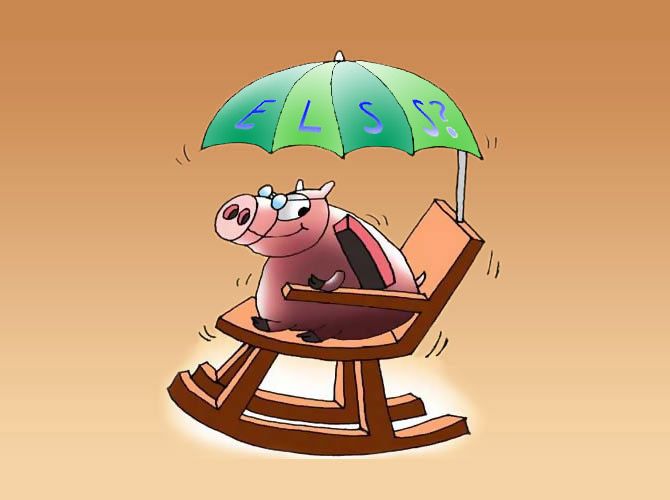 | « Back to article | Print this article |
A mistake here can prove costly.
Arnav Pandya on what investors should take into consideration when choosing an ELSS fund.
Illustration: Uttam Ghosh/Rediff.com

Most tax payers scramble to make their tax-saving investments during the last few months of the financial year.
Investors need to plan properly while investing to meet the Rs 1.5 lakh limit under Section 80C.
Not only should these investments help them save tax, they should also offer them sound returns and enable them to meet their financial goals.
With the equity markets scaling new highs, equity linked savings schemes (ELSS) are looming large on investors' radar.
While these funds do offer many advantages, investors should not enter them without being fully aware of their risks.
1. Full equity exposure and higher returns
One characteristic that differentiates ELSS funds from other Section 80C instruments is that they give complete equity exposure to the investor.
Most other tax-saving instruments (barring Ulips) under Section 80C are debt oriented.
High equity exposure is suitable for investors who are young and have the necessary risk appetite for the volatility that investment in an equity-oriented scheme entails, since longer-term returns tend to be higher.
Tax-saving schemes have given an average compounded annual return of 14.89 per cent over the past three years and 18.86 per cent over the past five years, according to Value Research, a mutual fund rating agency.
These returns are much higher than what investors would have earned from debt-oriented products such as Public Provident Fund, Employees' Provident Fund, National Savings Certificates, and even tax-saving bank fixed deposits.
2. Tax-free return
Investors get a huge boost on the tax front in ELSS since the returns receive a favourable tax treatment.
The dividend from these funds is tax free. Also, owing to the lock-in, investors can only sell their units after three years.
By then, the capital gains earned from these funds become long term in nature, and hence are taxed at zero per cent, owing to the equity-oriented nature of these funds.
While the above-mentioned factors no doubt make these funds attractive, they also carry several risks that investors tend to ignore, especially in good times such as these, when returns have been high (the one-year average return from this category has been 39.50 per cent).
3. Exit challenge
ELSS funds have a lock-in of three years. After you have invested in them, conditions in the equity markets could deteriorate.
In that case, the returns from these funds could be very poor or even negative at the end of three years.
Due to the lock-in, there is nothing that the investor can do.
The only way s/he can tackle this situation is by remaining invested in the fund till the equity markets turn around.
This can take several years, hence investors need to be patient.
Thus, even though the lock-in in these funds is only three years, investors should enter them with a horizon of at least five years, or better still, seven years.
It has been seen that if one remains invested in equities for longer, the chances of negative returns diminish.
4. Tax changes
Another risk that investors face in ELSS funds is that if there are changes in the tax structure after the investment has been made, there is little they can do about it.
The investor would have to just grin and bear the changes.
The tough part is that owing to the lock in they won't even have the option to exit their investment before the new rules come into effect.
There is little that can be done to mitigate this risk. However, with the main tax benefit of deduction already claimed upfront, the downside is limited.
5. Fund house mergers
Mergers and acquisitions of fund houses happen quite regularly these days.
If the fund house whose fund an investor bought gets taken over by another, that entails some risk for the investor.
A new fund manager could take over. Its performance could deteriorate after the merger.
In such a situation, there is little the investor can do because w/he has to fulfil the lock in condition to avail of the tax benefit.
6. Inability to lock in gains
After you have invested in an ELSS fund, the markets, and along with it the fund, may scale new highs.
While the investor can rub his hands in glee upon seeing those returns, there is always the risk that s/he may never actually enjoy those returns.
By the time the fund's lock-in ends and s/he can withdraw his money, the markets and the fund may have retreated from those highs.
This can cause a lot of anguish to the investor who is unable to book her/his gains.
One way to reduce this risk is to opt for the dividend payout option so that at least a part of the gains earned each year get paid out to the investor.
7. Selecting the right fund
Choosing the right ELSS fund becomes important for the investor because this is a long-term investment and there is little you can do owing to the lock-in.
A mistake here can prove costly.
Here are a few points that investors should take into consideration when choosing an ELSS fund:
Arnav Pandya is a certified financial planner